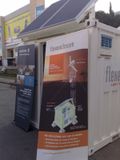Looking for an apartment is a tough job as you can probably imagine, especially if you are looking far away from your home town. Here are some reflections from an Internet and mobility point of view from such an undertaking.
Preparation
No idea how apartment hunting worked in the days before the Internet and mobile phones, but I am sure the experience must have been tough. The non wireless part of the search from a technology point of view is of course the Internet and good web portals with apartment offers. For Germany, Immobilienscout24 is a good place to start. From there, I assembled a list of apartments I wanted to see and contacted the real-estate agents for appointments a couple of days before traveling to my new hometown. Already here, mobile technology helped a lot as most agents are not really sitting around in their office waiting for their desk phones to ring.
Navigation
Once on the ground, the mobile phone on my end came into the game. Most agents called me a day or a couple of hours before the meeting to make sure I hadn't lost interest. I big time saver for them. A big time saver on my end was Nokia maps on my N95 as navigating through an unknown city is much easier that way. When new to a town, for example, it's often confusing when one should get out of the bus or tram unless of course there is some mobile GPS help in your phone and you can see the destination in the maps application and your location relative to it in real time.
Netbook Help
After having seen some apartments and getting a first feeling for the city and the different neighborhoods, I decided that some parts of town I hadn't considered so far would also be a good place to live. The netbook I recently bought and a wireless Internet connection were quite helpful while still out and about to find some more interesting places to see. This worked well and the mobile phone was very useful to contact agents and arrange for a meeting immediately or the next day. That saved a lot of time as well as it's not necessary to wait until you are back home in the evening. Instead, it can be done between two appointments.
Remove all the technology invented in the past 20 years from this experience and it would have looked entirely different.
The Future
I can't remember exactly where I've seen it before but I can imagine that augmented reality could help to make the process even smoother in the future. Hold your GPS and compass enabled camera phone into the direction of a street you think would be nice to live in and your location and direction will be sent to a server on the net (just like my apartment search portal I used manually). The server then queries the database, returns the available apartments close by that fit my preferences and the phone shows them as an overlay to the image I see on the screen. Yes, I can well imagine that and it would have been great to have it as I often thought that a street looked particularly nice and that it would be great to find something here. Well, still in the future today, but I wonder if 20 years from now people will wonder how they could have ever found an apartment without this technology!?
